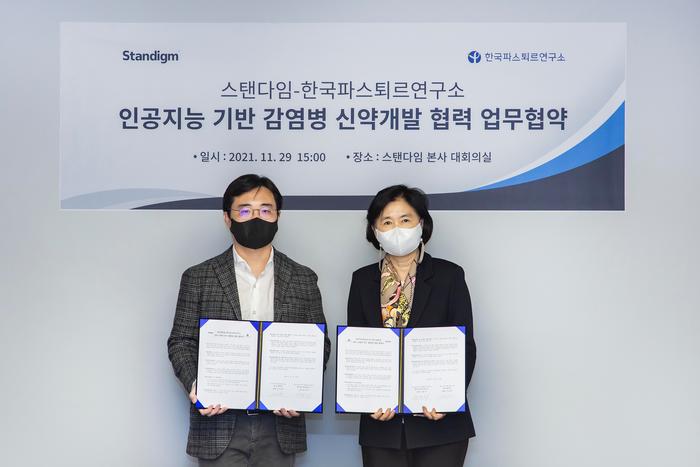Standigm, a prominent workflow artificial intelligence (AI) drug discovery company, recently signed a Memorandum of Understanding (MOU) with Institut Pasteur Korea (IPK), the infectious disease-focused research organization contributing to public health, for AI-based drug discovery study for infectious disease.

The MOU signing happened at Standigm’s headquarters, attended by Jinhan Kim, CEO of Standigm, and Youngmee Jee, CEO of IPK. The MOU brings together Standigm’s AI drug discovery platform and IPK’s research proficiency in infectious disease.
The two parties will vigorously carry out joint research and academic exchanges to develop advanced drug options for infectious disease, establishing the research priority on finding unique anti-tubercular drug candidates.
Formerly, the two parties carried out a research partnership on anti-tubercular drug discovery, employing Standigm’s deep learning technology to the data produced via IPK’s cell-based screening of one hundred thousand compounds against tuberculosis.
Consequently, hit compounds with numerous key scaffolds functional in multidrug-resistant and extensively drug-resistant tuberculosis (MDR/XDR-TB) were detected.
The subsequent research on these hits, “Validation and optimization of an AI-driven platform for anti-tubercular drug discovery” has been chosen for the Research Investment for Global Health Technology Fund’s (“RIGHT Fund”) “Technical Accelerator Award”.
The RIGHT Fund is an international health research funding foundation set up in 2018 via the public-private partnership between the Ministry of Health and Welfare of South Korea, the Bill & Melinda Gates Foundation (BMGF), and Korean life science companies to look into the medical and technological requirements toward easing the burden of infectious diseases particularly in developing nations.
Standigm has been chosen as a grantee for the RIGHT Fund’s advanced infectious disease R&D project with IPK as its collaborating research partner.
Based on a list of important scaffolds detected in the earlier research partnership, Standigm will investigate unique lead structures with enhanced anti-tubercular activity. For this, Standigm will employ its exclusive AI platform for compound design (Standigm BESTTM). The scaffold-based generation module will produce unique anti-tubercular molecules based on predetermined key scaffolds.
Following that, the activity prediction model which deep learned 3D molecular features will rank the most active anti-tubercular compounds and choose the final candidates for production.
IPK will synthesize the virtual candidates obtained by Standigm into real chemical compounds and assess their efficacy, making use of years of expertise in anti-tubercular drug discovery research. Each compound will be examined and confirmed through cell culture experiments using IPK’s image-based screening platform in the biosafety level-3.
There are considerable difficulties in anti-tubercular drug discovery, such as resistance and interaction with other drugs. It is not easy to recover drug development costs because it occurs frequently among socially and economically vulnerable groups, making it one of disease that needs the most innovation in the drug development process.
Jinhan Kim, Co-founder and CEO, Standigm
“By pooling research expertise of IPK and Standigm’s AI technology together, we expect to accelerate the discovery of innovative new tuberculosis drugs by reducing the time and cost compared to traditional methodologies,” he added.
Through this research collaboration with Standigm, we will establish and verify innovative strategies that can accelerate AI-based infectious disease research, and improve the efficiency of drug discovery.
Youngmee Jee, CEO, IPK
“Furthermore, we will continue multidimensional research and collaborations, including conducting follow-up research to commercialize the new anti-tubercular drug candidate developed by the IPK, TTCA, and contribute to the worldwide efforts to end the tuberculosis epidemic by 2030,” she continued.
Source: https://www.standigm.com/main
Credit: Source link





















